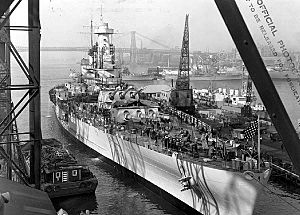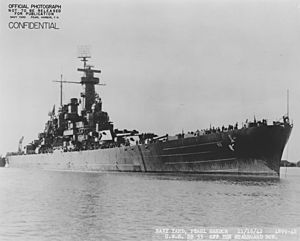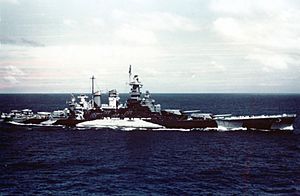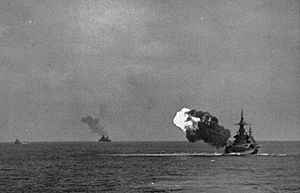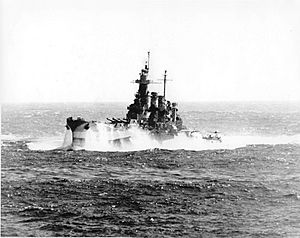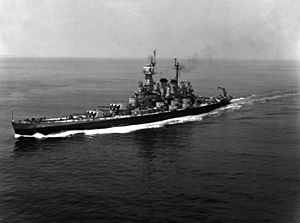USS North Carolina (BB-55) facts for kids
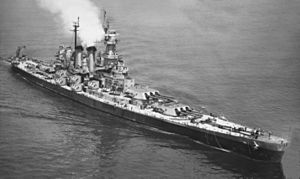
North Carolina underway on 3 June 1946.
|
|
Quick facts for kids History |
|
|---|---|
| Name | North Carolina |
| Namesake | State of North Carolina |
| Ordered | 1 August 1937 |
| Builder | New York Naval Shipyard |
| Laid down | 27 October 1937 |
| Launched | 13 June 1940 |
| Commissioned | 9 April 1941 |
| Decommissioned | 27 June 1947 |
| Stricken | 1 June 1960 |
| Nickname(s) | "Showboat" |
| Status | Museum ship since 29 April 1962 in Wilmington, North Carolina |
| General characteristics | |
| Class and type | North Carolina-class battleship |
| Displacement | |
| Length | 728 ft 9 in (222.12 m) |
| Beam | 108 ft 4 in (33.02 m) |
| Draft | 32 ft 11.5 in (10.046 m) |
| Installed power |
|
| Propulsion | |
| Speed | 28 knots (52 km/h; 32 mph) |
| Range | 17,450 nmi (32,320 km; 20,080 mi) at 15 knots (28 km/h; 17 mph) |
| Complement | 1,800 |
| Armament |
|
| Armor |
|
| Aircraft carried | 3 × Vought OS2U Kingfisher floatplanes |
| Aviation facilities | 2 × trainable catapults on her fantail |
The USS North Carolina (BB-55) was the first of a new type of fast battleship built for the United States Navy. It was designed under rules from the Washington Naval Treaty. This treaty limited how big warships could be and what weapons they could carry. However, the United States was able to use a special rule to give North Carolina nine 16-inch guns instead of the smaller 14-inch guns originally planned.
The ship was started in 1937 and finished in April 1941. At this time, the United States was not yet involved in World War II. After Japan attacked Pearl Harbor in December 1941, North Carolina joined the war effort. It was first sent to watch for a German battleship, but then moved to the Pacific Ocean. There, it helped protect aircraft carriers during the Guadalcanal Campaign.
North Carolina fought in the Battle of the Eastern Solomons in August 1942. It shot down several Japanese planes. The next month, a Japanese submarine hit the ship with a torpedo, but the damage was not serious. After repairs, it continued to protect carriers in battles across the Pacific in 1943 and 1944. This included the Battle of the Philippine Sea.
The ship was being repaired during the invasion of the Philippines. But it later joined the fighting in the Philippines. It was also there when a strong storm, Typhoon Cobra, hit the fleet. In 1945, North Carolina supported the Battles of Iwo Jima and Okinawa. It also took part in attacks on Japan itself. After Japan surrendered in August, the ship helped bring American soldiers home.
North Carolina operated for a short time in 1946. Then, it was taken out of service in 1947 and kept in reserve. In 1960, it was going to be scrapped. But a group of people worked hard to save it. They wanted to turn it into a museum ship in its home state. In 1962, the North Carolina museum opened in Wilmington, North Carolina.
Contents
Understanding the Design of USS North Carolina
The North Carolina class was the first new battleship design built after the Washington Naval Treaty. Its design had to follow the rules of the Second London Naval Treaty of 1936. This treaty said that the ship's main guns could be no bigger than 14 inches. The US Navy looked at many designs. They finally chose a fast battleship with twelve 14-inch guns.
However, Japan refused to sign the treaty. Because of this, the United States used a special rule in the treaty. This rule allowed them to increase the size of the guns to 16 inches.
North Carolina was about 728 feet 9 inches long. It was 108 feet 4 inches wide and sat 32 feet 11.5 inches deep in the water. The ship weighed about 35,000 long tons when empty. It weighed 44,800 long tons when fully loaded for battle.
The ship had four steam turbines. Each turbine powered one propeller. Eight oil-fired boilers made the steam for the turbines. These engines produced 121,000 horsepower. This power was meant to give the ship a top speed of 28 knots (about 32 miles per hour). The ship could travel 17,450 nautical miles (about 20,080 miles) at a speed of 15 knots.
It carried three Vought OS2U Kingfisher floatplanes. These planes were used for scouting the area. Two aircraft catapults on the back of the ship launched them. In peacetime, the crew had 1,800 sailors. But during the war, the crew grew to 99 officers and 2,035 enlisted sailors.
Weapons and Protection of the Battleship
The main weapons of North Carolina were nine 16-inch guns. These guns were in three turrets. Two turrets were at the front of the ship, with one placed higher than the other. The third turret was at the back.
The ship also had twenty 5-inch guns. These were in twin turrets along the sides of the ship. These guns could be used against both ships and aircraft. When first built, the ship also had sixteen 1.1-inch anti-aircraft guns and eighteen .50-caliber machine guns. Over time, its anti-aircraft weapons were greatly increased.
The main armor belt around the ship was 12 inches thick. The main armored deck was up to 5.5 inches thick. The front of the main gun turrets had 16-inch thick armor. The command center, called the conning tower, had 14.7-inch thick sides. The ship's armor was designed to protect against 14-inch guns. Even though the treaty rules changed, the design could not be updated for heavier guns. Still, the North Carolina class proved to be very good battleships.
Upgrades and Changes During the War
North Carolina received many upgrades during its time in service. Most of these changes were to its radar and anti-aircraft guns. By November 1942, the ship had several radar sets. These included radars for its main guns, secondary guns, and for searching the air and surface.
During a repair period in early 1944, it received even more advanced radar systems. These new radars helped the ship track targets better.
The anti-aircraft guns were also greatly improved. By late 1942, the ship had forty 40 mm Bofors guns in ten mounts. It also had forty-six 20 mm Oerlikon cannons. More of these guns were added in 1943 and 1945. By the end of the war, the ship had a very strong defense against air attacks.
Service History of USS North Carolina
The building of North Carolina began on October 27, 1937, at the New York Naval Shipyard. The ship was launched on June 13, 1940. It officially joined the fleet on April 9, 1941. The ship then went on a test trip in the Caribbean Sea. It spent the rest of 1941 training.
After the Japanese attack on Pearl Harbor on December 7, 1941, North Carolina began intense training for combat. Its first mission in April 1942 was to the North Atlantic. It was part of a group meant to stop the German battleship Tirpitz. But Tirpitz stayed in Norway. So, North Carolina was quickly sent to the Pacific in mid-1942. It sailed through the Panama Canal on June 10.
Fighting in the Guadalcanal Campaign
North Carolina joined the Guadalcanal Campaign as part of Task Force 16. This group included the aircraft carrier Enterprise. Their job was to protect the landing of US Marines on Guadalcanal in August 1942. North Carolina stayed with Enterprise to protect it from Japanese air attacks.
On August 24–25, North Carolina took part in the Battle of the Eastern Solomons. The ship's radar detected Japanese planes. North Carolina used its anti-aircraft guns to help defend Enterprise. Several Japanese dive bombers attacked North Carolina, but they all missed. One sailor was killed by a strafing plane, but the ship was not seriously damaged. North Carolina claimed to have shot down many Japanese planes. Its 5-inch guns were very effective.
After Enterprise left for repairs, North Carolina moved to protect the carrier Saratoga. On September 15, a Japanese submarine, I-19, fired torpedoes. One torpedo hit North Carolina on its left side, 20 feet below the water. It made a large hole. Five sailors were killed. The blast also damaged the front gun turret. The ship listed to one side, but the crew quickly fixed it. North Carolina was able to keep sailing at 25 knots. Two other ships hit by the same torpedoes, Wasp and O'Brien, were sunk or later foundered. North Carolina went to Pearl Harbor for repairs, which lasted until November.
After repairs, North Carolina returned to the South Pacific. It continued to protect Saratoga and Enterprise. It also covered convoys carrying soldiers and supplies to the Solomon Islands in late 1942 and early 1943. In March, North Carolina went to Pearl Harbor for more upgrades, including new radars. It then joined other battleships to cover amphibious attacks in June and July. In September, it prepared for the attack on the Gilbert Islands.
Battles in the Gilbert and Marshall Islands
For the attack on the Gilberts, North Carolina sailed on November 10, 1943, with Enterprise. It supported attacks on Makin, Tarawa, and Abemama. North Carolina protected the carriers as they bombed the islands. On December 8, North Carolina joined other battleships to bombard Nauru island. It then escorted the carrier Bunker Hill during attacks on Kavieng in late December.
In January 1944, North Carolina continued to escort carriers as part of Task Force 58. During the Battle of Kwajalein, North Carolina helped bombard the island of Roi-Namur. It sank a cargo ship in the harbor. After this battle, Task Force 58 attacked Truk, a major Japanese base. This attack, called Operation Hailstone, caused huge damage to Japanese ships and planes.
The fleet then carried out raids in the central Pacific to prepare for the attack on the Mariana Islands. In late March, the fleet attacked Palau and Woleai. North Carolina shot down a Japanese plane during these operations. It then supported the US Army's landing at Hollandia in New Guinea in April. Another attack on Truk followed. North Carolina shot down another Japanese plane. On May 1, North Carolina and other battleships bombarded Pohnpei, destroying Japanese guns and damaging the airfield.
Fighting in the Mariana and Palau Islands
After repairs to its rudder, North Carolina rejoined the fleet for the attack on the Marianas. On June 6, the fleet sailed to attack Saipan. North Carolina protected the carriers and also shelled the island. It hit Tanapag Harbor, sank small boats, and destroyed supply areas. On June 15, US Marines landed. A Japanese counterattack came, and North Carolina shot down one of the enemy planes. This landing led to a big naval battle.
As the Japanese fleet approached, North Carolina and the rest of Task Force 58 sailed to meet them. This led to the Battle of the Philippine Sea on June 19–20. North Carolina and other battleships were positioned to protect the carriers. They were among the first to fire on the attacking Japanese planes. The US fleet won a huge victory, destroying hundreds of Japanese aircraft and sinking three carriers. North Carolina shot down two Japanese planes during the battle. It stayed near the Marianas for two more weeks. Then, it went to the Puget Sound Naval Shipyard for repairs.
Later Operations and the End of the War
Repairs kept North Carolina out of much of the Philippines campaign. It rejoined the fleet in November at Ulithi. The carriers then attacked Japanese positions in the Philippines to support Army operations. North Carolina shot down a kamikaze plane during these attacks. In December, the fleet was hit by Typhoon Cobra. North Carolina was not badly damaged, but three destroyers sank.
In January 1945, the fleet attacked targets in Formosa, French Indochina, China, and the Ryuku Islands. North Carolina was part of these operations. The attacks continued into mid-January.
In February, North Carolina escorted carriers during attacks on Honshu, Japan. This was to weaken Japanese air forces before the invasion of Iwo Jima. North Carolina also helped bombard Iwo Jima to support the Marine assault. It provided fire support as they fought on the island.
After Iwo Jima, the fleet attacked the Japanese Home Islands to prepare for the invasion of Okinawa. The first attacks hit the Tokyo area. The fleet then raided Okinawa on March 1. While at Ulithi, North Carolina was moved to a different task group. The fleet sailed again on March 14 for more attacks on Japan, hitting targets on Kyushu.
Carrier attacks on Japan and the Ryukus continued after the landing on Okinawa on April 1. On April 6, North Carolina shot down three kamikaze planes. Another ship accidentally hit North Carolina with a 5-inch shell, killing three and wounding forty-four sailors. On April 7, Japan launched a big attack led by the battleship Yamato. North Carolina shot down one Japanese bomber. It shot down two more kamikazes on April 17. Two days later, it supported infantry attacks on Okinawa before going to Pearl Harbor for another overhaul.
North Carolina returned to the fleet in late June. It then began another series of attacks on Japan on July 1. Air attacks started on July 10, with over a thousand planes hitting airfields near Tokyo. These attacks continued for more than a week. One of North Carolina's Kingfisher planes rescued a downed pilot in Tokyo Bay under heavy fire.
After Japan surrendered on August 15, North Carolina helped with the initial occupation of Japan. It entered Sagami Bay on August 27. It patrolled the coast until September 5, then sailed into Tokyo Bay to pick up its men. The next day, it was assigned to a group to return to the United States. From there, it sailed to Okinawa to pick up soldiers going home as part of Operation Magic Carpet. During the war, 10 of its crew died and 67 were wounded.
It passed through the Panama Canal on October 8 and arrived in Boston on October 17. It then had repairs and trained off the east coast. This included a training trip for midshipmen in 1946. North Carolina was the only American treaty battleship to serve much after the war.
Becoming a Museum Ship
|
USS North Carolina (Battleship)
|
|

USS North Carolina Battleship Memorial
|
|
| Location | Wilmington, North Carolina |
|---|---|
| Built | 1941 |
| Architect | Brooklyn Navy Yard |
| NRHP reference No. | 82004893 |
| Significant dates | |
| Added to NRHP | 10 November 1982 |
| Designated NHL | 14 January 1986 |
North Carolina was taken out of service on June 27, 1947, in New York. It was kept in reserve. The Navy thought about updating or changing the ship for other uses. They considered making it faster or even turning it into a helicopter carrier. But they decided it would be too expensive or not practical.
The ship was going to be scrapped on June 1, 1960. But a man named James Craig started a campaign to save it. He wanted to preserve it as a museum ship, like the battleship Texas. He convinced the Governor of North Carolina to ask the Navy to delay scrapping the ship. Then, he led a campaign to raise $250,000. This money was needed to prepare a place for the ship, tow it there, and get it ready for visitors. With help from a TV station and newspapers, they raised over $330,000.
Three cities were considered for the ship's new home: Southport, Morehead City, and Wilmington. Wilmington was chosen because it was further inland and safer from hurricanes.
On September 6, 1961, North Carolina was given to the state. Nine tugboats towed the ship from Bayonne, New Jersey, to Wilmington on September 25. After its new home was ready and repairs were made, the ship officially opened to the public on April 29, 1962. In 1964, a Kingfisher plane that had crashed during the war was given to the museum. The battleship was named a National Historic Landmark on November 10, 1982. It was noted that the ship was in excellent condition and still looked like it did during the war.
Work to keep the ship in good shape is always happening. In 1998, a fundraising effort called Operation Ship Shape helped pay for repairs. This included replacing the ship's wooden deck. Funds also went to fix the ship's hull, which had worn thin in some places. Instead of moving the ship to a drydock, which would be very costly, they decided to build a special wall around the hull called a cofferdam. This would allow them to pump the water out and work on the hull. They will replace damaged parts and repaint the hull. In 2018, a walkway was built around the ship. This allows visitors to see the ship from all sides. The walkway sits on top of the cofferdam used for repairs.
Images for kids
See also
 In Spanish: USS North Carolina (BB-55) para niños
In Spanish: USS North Carolina (BB-55) para niños



